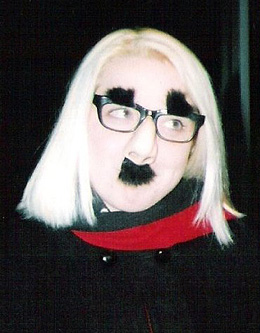A Family Cancer
Kerry Higgins was at a concert with her best friend from college. They were standing outside the arena when a guy to her left began to stare. He was looking at the two-foot long, jagged pink scar on Kerry’s right leg. He finally asked her what had happened to her. Without hesitation, she looked him in the eyes and said, “I was attacked by a shark.”
“The delivery was so deadpan; you could tell the kid believed her,” said Sarah Spagnoli, her roommate and friend, recalling Kerry’s little act of deception. “That line was a favorite of hers when asked about her scar. The ability to crack jokes and be at peace with such a horrible experience showed just the kind of strength she has.”
At 20, she was diagnosed with Li-Fraumeni Syndrome, a disease that significantly increases her risk of developing numerous forms of cancer while she is still young. Now 25, she has been diagnosed and treated for three forms of cancer – in her bone, breast, and skin. When discussing her journey, though, the details bring her more often to laughter than sadness. Throughout her life, Kerry has had to accept the consequences of her genetic makeup. She’s managed to do that with a large dose of humor, ever since receiving her first diagnosis at the age of 12.
Track Star Dreams
Seventh grade classes were just beginning at Kerry’s small school in Athens, Pennsylvania, a farm town in the north-central part of the state. Kerry had been looking forward to joining the track team, and to skiing that winter. But what felt like a cramp in her right thigh had been bothering her. Soon, it hurt so much that her mother took her to the doctor.
Test results in hand, the doctors broke the news of the real reason for her discomfort: a tumor had invaded her upper-thigh bone. The hospital in Athens lacked the personnel and equipment to treat Kerry, so the family was referred to Henry Mankin, the chief of surgery at Boston’s Massachusetts General Hospital, renowned for his pioneering treatment techniques. To Kerry, Mankin looked like Albert Einsten. And he had a plan. He told Kerry that her leg would not have to be amputated – but that she would have to undergo major surgery, and chemotherapy, instead.
Over the next year, Kerry’s life was all about treatment. Track and skiing were out of the question. Her mother became her main caregiver, sleeping beside her in hospital rooms. Her father, a real estate appraiser, kept busy with his work and dealt with the diagnosis quietly, caring for their other four children – a son and daughter from his wife’s first marriage, and their younger twin girls, Maureen and Eileen.
Within two weeks of her diagnosis, Kerry started chemotherapy at a hospital in Syracuse, NY. Kerry and her mom shuttled between home and hospitals. She would spend a week in the hospital, receiving the chemo and recovering from the side effects, and then return home for about a week, before returning to Syracuse for the next treatment. The prescribed toxic platinum-based chemical sucked 30 pounds from her slightly chubby, 5’2’’ frame. Her hair fell out during the first month of treatment. Doctors attempted to use a bone graft to replace the cancer-riddled portion of Kerry’s leg. A cast stretched from her hip to mid-calf.
Still, she was determined to go to her junior high school’s Halloween dance.
“I painted my entire head white, my eye sockets black, and my mouth black,” she recalled. “My hands were all covered in white. My mom made me a broom handle sickle, and I wore my brother’s black graduation gown. And I went to the dance in my wheelchair.”
She went as Death. The thought still makes her chuckle. Today, the photo taken of her in that costume hangs in a collage on the wall in their front foyer.

